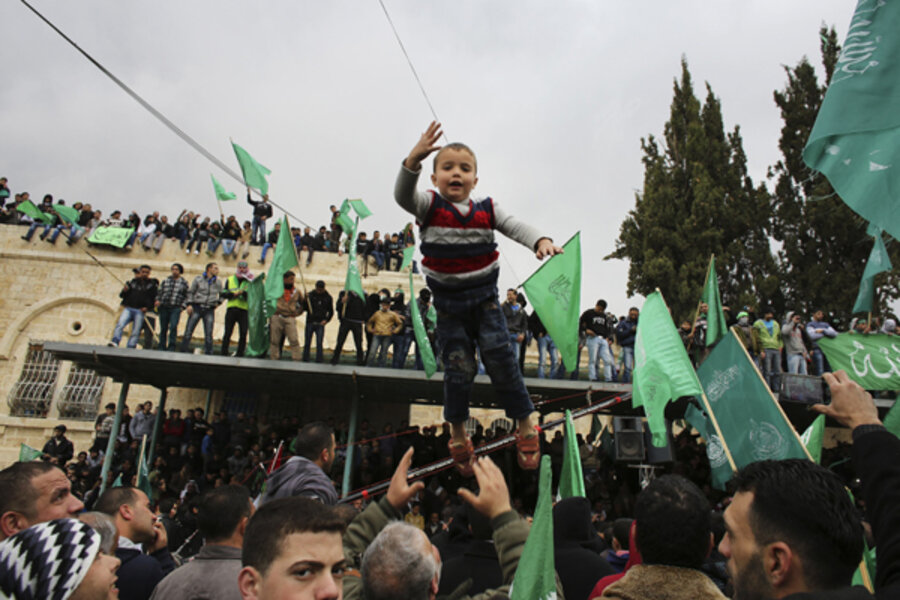West Bank welcomes Hamas back with excitement - and apprehension
Loading...
| Nablus, West Bank
Hamas, long suppressed in the West Bank because of its feud with Palestinian President Mahmoud Abbas, staged comeback parties in several cities here over the last two days in celebration of its 25th anniversary and victory in last month’s Gaza war.
For the first time in five years, thousands of Hamas supporters flooded central Nablus yesterday, waving green Islamist banners and miniature rockets symbolizing those fired from Gaza at Israeli cities, giving voice to fiery rhetoric not heard in this town since the second intifada of the early 2000s.
"We will pledge to purify our people from all Zionist rhetoric," shouted a speaker in Nablus yesterday. "Your objective: resistance. Your leaders: Hamas. Your wish: to die in the name of God… Create a volcano among the Israelis."
Yesterday's demonstration, together with similar celebrations sanctioned by Mr. Abbas’ government planned for today in Ramallah and Hebron, signal just how much Hamas’s stature in the region has grown since the war, which lifted Palestinian morale and even spurred new hopes for a political reconciliation between long feuding Fatah and Hamas. Such rallies would have previously been shut down by Palestinian security forces.
But the Islamist renewal in the West Bank has also been accompanied by an uptick in clashes with the Israel Defense Forces (IDF), spurring questions in Israel about whether the sides have reached the threshold of a new Palestinian uprising. Some analysts believe years of calm and stability in the West Bank are coming to an end.
Around the same time as the Nablus demonstration, hundreds of Palestinian youth in Hebron clashed with Israeli soldiers after the funeral of a local teenager who was killed by the IDF two days ago. According to the army, the minor attacked a solder with a fake gun, which a second soldier who opened fire believed to be real. Israel Radio reported today that security forces were bracing themselves for a new round of clashes following weekly prayer services.
Nathan Thrall, a Middle East analyst with the International Crisis Group, says tensions began rising after Palestinian protests against economic austerity measures several months ago. Those protests first were directed at the PA, and then at Israel.
"Tensions really have increased since the Gaza war. It’s clear that there’s less restraint than there had been a month ago," he says. "Protests had already started in September, when people had been challenging the PA and Israel in a way they hadn’t in some time. The Gaza war continued that."
Reconciliation or politics?
Participants in the Nablus rally yesterday seemed limited to Islamists, and the turnout was only a fraction of the hundreds of thousands who attended anniversary celebrations of the militant group in Gaza, which Hamas has controlled since a takeover in 2007. The remarkable thing about it was that it happened at all. For the last few years, the Palestinian Authority has been arresting Hamas activists and shutting down Islamist charity groups.
Analysts see the switch as a sign that the PA is bowing to the growing stature of Hamas. Both Fatah and Hamas have allowed their rivals to hold political demonstrations in the area under control, to make gestures toward reconciliation. But few observers believe the conditions have ripened for a true end to the rift.
"The victory in Gaza has created a lot of interest in Hamas and its strategy in the West Bank," says Khulud el-Masry, a participant in the Nablus rally whose Islamic non-profit was once shuttered by the PA. "I feel now that this has began the process of reconciliation, and when the there is reconciliation, our program will triumph over the others."
But the militant sentiment expressed at the rally is anathema to President Abbas, who has staked his political career on the idea that diplomacy and negotiations with Israel are the only path toward Palestinian statehood. In both Nablus and Gaza, speakers at the Hamas rallies talked up armed conflict and ruled out making any accommodations to Israel.
Despite that, Abbas has sanctioned representatives of his Fatah party to appear at the various Hamas rallies to signal his desire to make amends.
"Since the Israeli assault on Gaza, the whole atmosphere has changed, and the spirit of unity has come from and center," said Nour Odeh, a spokeswoman for the Palestinian Authority in Ramallah.
But an official in the Nablus governorate, who asked to remain anonymous because he wasn’t authorized to discuss politics, says that the PA’s tolerance of the rallies is not an indication of a genuine interest in reconciliation, but merely an acknowledgement of the growing public support for the group.
"In spite of some positive symbolic signs, I’m not optimistic because the two sides are still sticking to their fundamental positions and behavior," says Ghassan Khatib, a professor at Bir Zeit University and a former PA spokesman, echoing the Nablus official's argument. "I don’t see them moving toward each other on the fundamental issues."
Threat of escalation
The new official tolerance of Hamas in the West Bank has some Israelis worried that the Gaza war heralds a phase of more frequent clashes between Palestinians and the military. In addition to two days of clashes with the IDF over the killing of the 17-year-old in Hebron, a passing car fired shots at an Israeli girl waiting outside the settlement of Neve Tsuf.
The military "is preparing for a scenario in which events of the past month lead to broader and more violent incidents, something there hasn’t been in the territories for many years," the daily newspaper Maariv reported yesterday.
However, the IDF has said on the record that it hasn't observed much change in the period since the end of the war, and yesterday the IDF presence at the main checkpoint into Nablus remained minimal. It has also sought to limit aggressive force to quash demonstrations.
Spokeswoman Odeh, however, contends that Palestinians are being pushed to the extreme by an uptick of Israeli raids and arrests in Palestinian cities.
The tense situation has been compounded by Israel’s recent decision to halt $120 million of tax and customs fees to the Palestinian Authority, a move which left the government without money to pay November salaries. Yesterday the Palestinian cabinet warned that if the situation continues, it will not be able to perform basic services, and tensions could climb further.
Palestinians wary, too
Despite the morale boost from the Gaza war and Hamas’ newfound prestige, many Palestinians in Nablus are uneasy about the idea of a return to the armed uprising that turned this city into a den of chaos, violence, and deprivation a decade ago. The billboard-sized banners of militants – or martyrs, as they are often referred to here – killed by Israel have been replaced by advertisements for cell phones and retail stores. Many in the West Bank who voted for Hamas in 2006 have expressed regrets about Hamas's rule in Gaza.
"Hamas lives in a hole, and sometimes they come out to show their face and go back," says Jamal Tufah, the owner of a watch store located across the street from the rally. "Nobody wants to go back to a third intifada. We can’t afford to build and then have everything destroyed."
But if Abbas' efforts at negotiations with Israel continue to be fruitless, the frustration of a minority may drag the West Bank into a wider conflict with Israel. Back outside at the Hamas demonstration, Nawaf Alamer, a producer at Hamas’ television station, insisted that modest turnout at the rally belies a broader dormant sympathy with the Islamists in the West Bank that has yet to be exposed.
"This is an indicator that carries a lot of signals," he says. "The people say that under the ashes, the coals are red hot."








